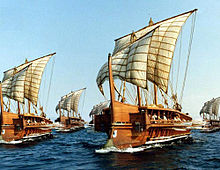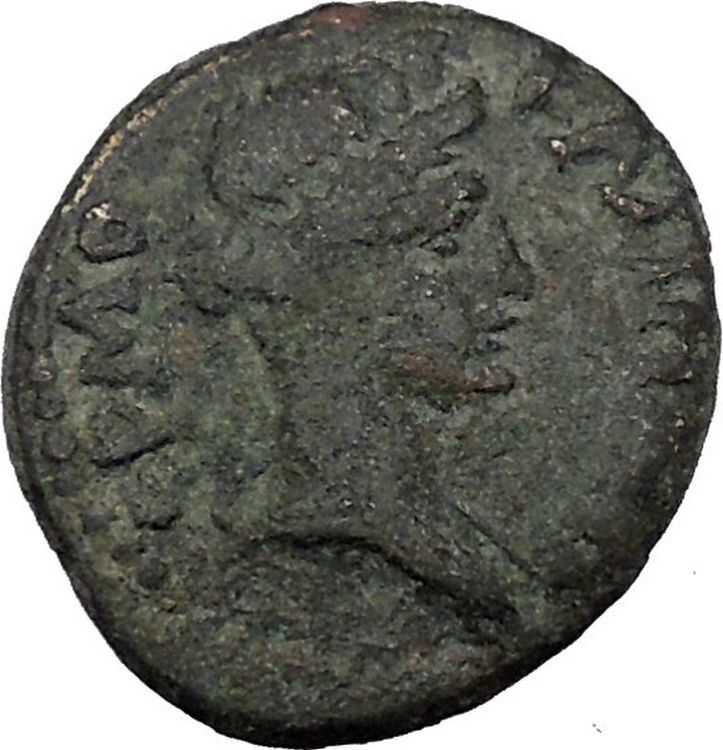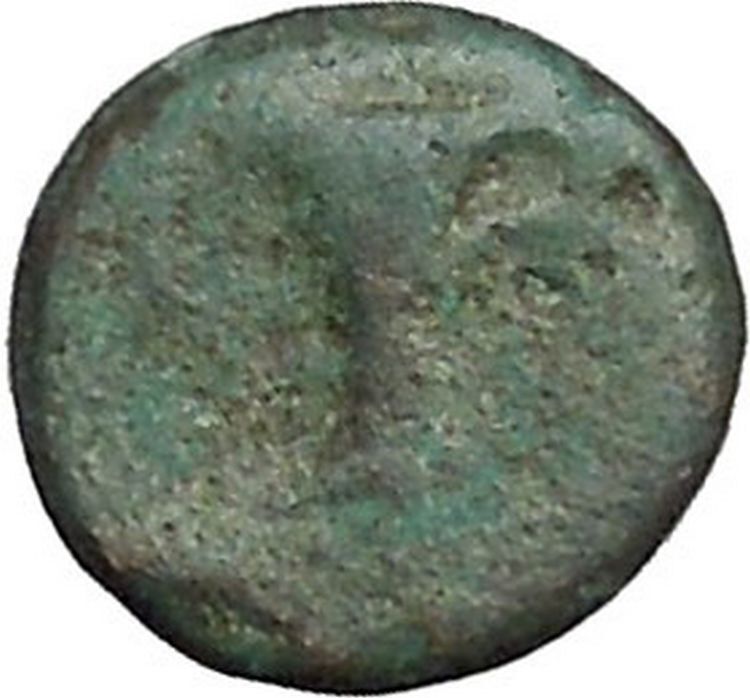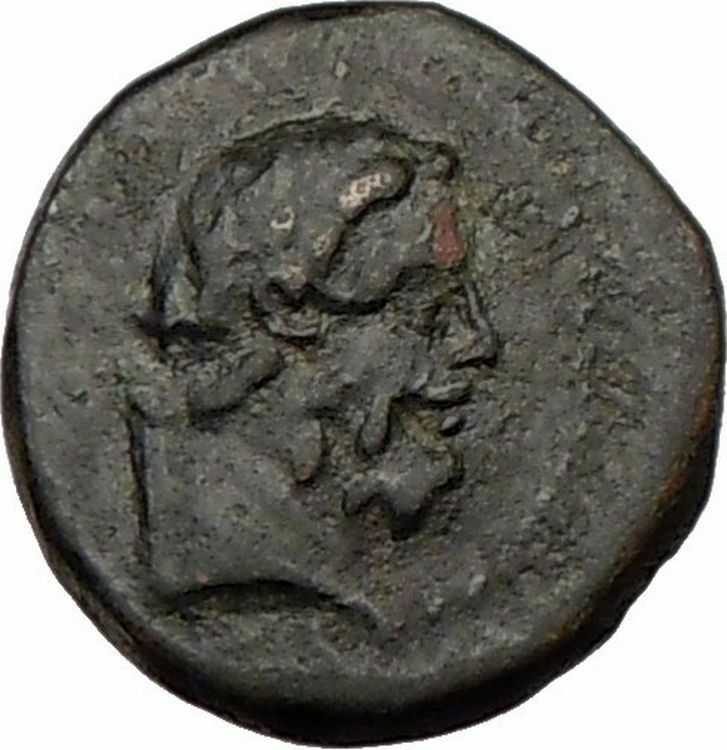|
Greek Coin of
Seleucid Kingdom
Seleukos IV, Philopator – King: 187-175 B.C.
Serrated Bronze 18mm (6.47 grams)
Antioch on the Orontes mint
Reference: HGC 9, 586; SC 1316 and 1321
Wreathed bust of Dionysus right, thyrsos over shoulder.
ΒΑΣΙΛΕΩΣ / ΣEΛΕYKOY above
and below prow of galley left.
You are bidding on the exact item pictured,
provided with a Certificate of Authenticity and Lifetime Guarantee of
Authenticity.

A
galley is a type of
ship propelled by
rowers
that originated in the eastern
Mediterranean Sea
and was used for
warfare
,
trade
and
piracy
from the first millennium BC. Galleys
dominated
naval warfare
in the Mediterranean from the 8th
century BC until development of advanced sailing warships in the 17th century.
Galleys fought in the wars of
Assyria
, ancient
Phoenicia
,
Greece
,
Carthage
and
Rome
until the 4th century AD. After the fall
of the
Western Roman Empire
galleys formed the
mainstay of the
Byzantine navy
and other navies of successors
of the Roman Empire, as well as new
Muslim
navies. Medieval Mediterranean states,
notably the Italian maritime republics, including
Venice
,
Pisa
,
Genoa
and the
Ottoman Empire
relied on them as the primary
warships of their fleets until the 17th century, when they were gradually
replaced by sailing warships. Galleys continued to be applied in minor roles in
the Mediterranean and the
Baltic Sea
even after the introduction of
steam propelled
ships in the early 19th
century.
The galley engagements at
Actium
and
Lepanto
are among the greatest
naval battles
in history.
Dionysus
is the god of the
grape harvest, winemaking and wine, of ritual madness, fertility, theatre and
religious ecstasy in
Greek mythology
. Alcohol, especially
wine, played an important role in Greek
![2nd century Roman statue of Dionysus, after a Hellenistic model (ex-coll. Cardinal Richelieu, Louvre[1])](https://upload.wikimedia.org/wikipedia/commons/thumb/8/8a/Dionysos_Louvre_Ma87_n2.jpg/200px-Dionysos_Louvre_Ma87_n2.jpg)
culture
with Dionysus being an important reason for this life style. His name, thought
to be a theonym
in
Linear B
tablets as di-wo-nu-so (KH
Gq 5 inscription), shows that he may have been worshipped as early as c.
1500–1100 BC by
Mycenean Greeks
; other traces of the
Dionysian-type cult have been found in ancient
Minoan Crete
. His origins are uncertain, and
his cults took many forms; some are described by ancient sources as Thracian,
others as Greek. In some cults, he arrives from the east, as an Asiatic
foreigner; in others, from
Ethiopia
in the South. He is a god of
epiphany
, “the god that comes”, and his
“foreignness” as an arriving outsider-god may be inherent and essential to his
cults. He is a major, popular figure of
Greek mythology
and
religion
, and is included in some lists of the
twelve Olympians
. Dionysus was the last god to
be accepted into Mt. Olympus. He was the youngest and the only one to have a
mortal mother. His festivals were the driving force behind the development of
Greek theatre
. He is an example of a
dying god
.
The earliest cult images of Dionysus show a mature male, bearded and robed.
He holds a fennel
staff, tipped with a pine-cone and known
as a thyrsus
. Later images show him as a
beardless, sensuous, naked or half-naked androgynous youth: the literature
describes him as womanly or “man-womanish”. In its fully developed form, his
central cult imagery shows his triumphant, disorderly arrival or return, as if
from some place beyond the borders of the known and civilized. His procession
(thiasus)
is made up of wild female followers (maenads)
and bearded
satyrs
with
erect penises
. Some are armed with the
thyrsus, some dance or play music. The god himself is drawn in a chariot,
usually by exotic beasts such as lions or tigers, and is sometimes attended by a
bearded, drunken Silenus
. This procession is presumed to be the
cult model for the human followers of his
Dionysian Mysteries
. In his
Thracian
mysteries, he wears the bassaris
or
fox-skin, symbolizing a new life. Dionysus is represented by city
religions as the protector of those who do not belong to conventional society
and thus symbolizes everything which is chaotic, dangerous and unexpected,
everything which escapes human reason and which can only be attributed to the
unforeseeable action of the gods.
Also known as Bacchus, the name adopted by the
Romans
and the frenzy he induces, bakkheia.
His thyrsus is sometimes wound with ivy and dripping with honey. It is a
beneficent wand but also a weapon, and can be used to destroy those who oppose
his cult and the freedoms he represents. He is also called Eleutherios
(“the liberator”), whose wine, music and ecstatic dance frees his followers from
self-conscious fear and care, and subverts the oppressive restraints of the
powerful. Those who partake of his mysteries are possessed and empowered by the
god himself. His cult is also a “cult of the souls”; his maenads feed the dead
through blood-offerings, and he acts as a divine communicant between the living
and the dead.
In Greek mythology, he is presented as a son of
Zeus and the mortal
Semele
, thus semi-divine or
heroic: and as son of Zeus and
Persephone
or
Demeter
, thus both fully divine, part-chthonic
and possibly identical with
Iacchus
of the
Eleusinian Mysteries
. Some scholars believe
that Dionysus is a
syncretism
of a local Greek nature deity and a
more powerful god from
Thrace
or
Phrygia
such as
Sabazios
or
Zalmoxis
.
In
Greek mythology
, a thyrsus or thyrsos
(Greek:
θύρσος
) was a staff of
giant fennel
(Ferula communis) covered
with ivy
vines and leaves, sometimes wound with
taeniae
and always topped with a
pine
cone
. These staffs were carried by
Dionysus
and his followers.
Euripides
wrote that
honey
dripped from the thyrsos staves that the
Bacchic
maenads
carried.The thyrsus was a sacred
instrument at religious rituals and
fêtes.
Symbolism
The thyrsus, associated with
Dionysus
(or Bacchus) and his followers, the
Satyrs
and
Maenads
, is a symbol of
prosperity
,
fertility
,
hedonism
, and pleasure/enjoyment in general. It
has been suggested that this was specifically a fertility
phallus
, with the fennel representing the shaft
of the penis and the pine cone representing the “seed” issuing forth. The
thyrsus was tossed in the Bacchic dance:
Pentheus: The thyrsus— in my right hand shall I hold it?
-
- Or thus am I more like a Bacchanal?
Dionysus: In thy right hand, and with thy right foot raise it”
Sometimes the thyrsus was displayed in conjunction with a
kantharos
wine cup, another symbol of Dionysus,
forming a male-and-female combination like that of the royal scepter and orb.
Literature
In the Iliad
,
Diomedes
, one of the leading warriors of the
Achaeans
, mentions the thyrsus while speaking
to
Glaucus
, one of the
Lycian
commanders in the
Trojan army, about
Lycurgus
, the king of
Scyros
:
He it was that/drove the nursing women who were in charge/of frenzied
Bacchus through the land of Nysa,/and they flung their thyrsi on the ground
as/murderous Lycurgus beat them with his ox-/goad. (Iliad, Book
VI.132-37)
The thyrsus is explicitly attributed to Dionysus in
Euripides
‘s play
The Bacchae
as part of the costume of the
Dionysian cult.
…To raise my Bacchic shout, and clothe all who respond/ In fawnskin
habits, and put my thyrsus in their hands–/ The weapon wreathed with
ivy-shoots…” Euripides also writes, “There’s a brute wildness in the
fennel-wands—Reverence it well.” (The Bacchae and Other Plays, trans.
by Philip Vellacott, Penguin, 1954.)
Socrates
writes in
Phaedo
:
I conceive that the founders of the mysteries had a real meaning and were
not mere triflers when they intimated in a figure long ago that he who
passes unsanctified and uninitiated into the world below will live in a
slough, but that he who arrives there after initiation and purification will
dwell with the gods. For “many,” as they say in the mysteries, “are the
thyrsus bearers, but few are the mystics,”–meaning, as I interpret the
words, the true philosophers.
In Part II of
Johann Wolfgang von Goethe
‘s
Faust
,
Mephistopheles
tries to catch a
Lamia
, only to find out that she is an
illusion:
Well, then, a tall one I will catch…/And now a thyrsus-pole I
snatch!/Only a pine-cone as its head. (7775-7777)
Sookie Stackhouse notes the thyrsus carried by the maenad in the 2nd book of
The Southern Vampire Mysteries
.
She idly waved the long wand with the tuft on the end. It was called a
thyrsis [sic];
I’d looked maenad up in the encyclopedia. Now I could die educated. (Harris,
Charlaine (2006-09-01). “Living Dead in Dallas: A Sookie Stackhouse Novel”}
Gallery
-
A Bacchant holding a thyrsus: Malice, by
William-Adolphe Bouguereau
, 1899
-
Roman relief showing a Maenad holding a thyrsus (Prado,
Madrid
).
-
Bacchus Triumphant (1882)
by
John Reinhard Weguelin
-
A Maenad uses her thrysos to ward off a Satyr,
Attic red-figure
kylix
, circa 480 BC
Seleucus IV Philopator ((Greek:
Σέλευκος Δ΄ Φιλοπάτωρ; c. 218 – 175 BC), ruler of the
Hellenistic
Seleucid Empire
, reigned from 187 BC to 175 BC.
He was the second son and successor of
Antiochus III the Great
and
Laodice III
. Seleucus IV wed his sister
Laodice IV
, by whom he had three children: two
sons Antiochus,
Demetrius I Soter
and a daughter
Laodice V
.
He was compelled by financial necessities, created in part by the heavy
war-indemnity exacted by Rome, to pursue an ambitious policy. In an effort to
collect money to pay the Romans, he sent his minister
Heliodorus
to Jerusalem to seize the
Jewish temple
treasury.
The Bible tells of a prophecy given by a messenger angel in
Daniel 11:20
(NLT). The text states that
Seleucus “will be remembered as the king who sent a tax collector to maintain
the royal splendor.” The deuterocanonical lends more to this in
2 Maccabees 3:2-3
… “It came to pass that even
the kings themselves, and the princes esteemed the place [the Temple in
Jerusalem] worthy of the highest honour, and glorified the temple with very
great gifts: So that Seleucus king of Asia allowed out of his revenues all the
charges belonging to the ministry of the sacrifices.”
On his return from Jerusalem, Heliodorus assassinated Seleucus, and seized
the throne for himself. The true heir
Demetrius
, son of Seleucus, was now being
retained in Rome as a hostage, and the kingdom was seized by the younger brother
of Seleucus,
Antiochus IV Epiphanes
. Antiochus managed to
oust Heliodorus and an infant
son of Seleucus, also named Antiochus, was formal head of state for a few years
until Epiphanes had him murdered.
|






![2nd century Roman statue of Dionysus, after a Hellenistic model (ex-coll. Cardinal Richelieu, Louvre[1])](https://upload.wikimedia.org/wikipedia/commons/thumb/8/8a/Dionysos_Louvre_Ma87_n2.jpg/200px-Dionysos_Louvre_Ma87_n2.jpg)

_-_Mailice_(1899).jpg/83px-William-Adolphe_Bouguereau_(1825-1905)_-_Mailice_(1899).jpg)
_04b.jpg/116px-Ménade_relieve_romano_(Museo_del_Prado)_04b.jpg)
.jpg/76px-John_Reinhard_Weguelin_–_Bacchus_Triumphant_(1882).jpg)




